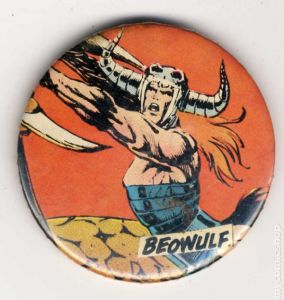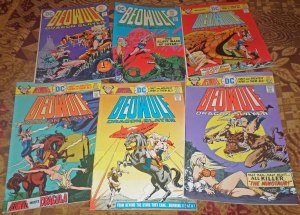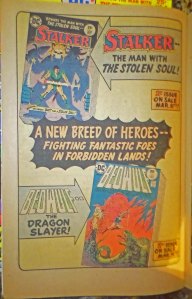“The First and Greatest Hero of Them All! Beowulf Dragon Slayer”
Anyone who took an English Lit class knows about Beowulf.
It is the oldest known epic poem in Old English. It has been translated and reviewed and critiqued more than almost any other book. Recently JRR Tolkien’s estate published his translation of the story. This is fitting, as “Beowulf” was one of Tolkien’s favorite subjects and you can hear the story’s echo throughout “Lord of the Rings” and most fantasy epics since.
In sum: hero Beowulf aids King Hrothgar in fighting Grendel, then Grendel’s mother, and - many years later after becoming king - gives his life defeating a dragon. Oh get off about spoiling the ending - it’s Beowulf ... People have been saying “Don’t spoil the ending” for over a thousand years now. Well, back then they said “Gefyllan na asecgan hit” but you get the idea.
As far as I can tell from my internet trolling, DC’s Beowulf Dragon Slayer is the first comic book adaptation of the character in a starring role. I found that hard to believe - no one wrote or drew a version in the Golden or early Silver Age? The letter column of issue #1 says there were many poor comic versions in the past, but I can only find a few pre-1975 comics with Beowulf in them. Usually just in a short story ala Tower of Shadows #6 from Marvel (circa 1970) or cameos ala Charleton’s Hercules back-up feature “Thane of Bagarth” (with excellent early work by Steven Skeates and Jim Aparo – the first four installments (of 12) were released as its own comic in the 1980s with back-up features by Steve Ditko – look for it)!
***
#1. May 1975, “The Curse of Castle Hrothgar”, Cover by Ricardo Villamonte, Michael Uslan (writer), Ricardo Villamonte (a), Denny O’Neil (e), Allan Asherman (asst ed). In a story not too far removed from the original epic tale, Grendel cannot stand the cheers and singing from Castle Hrothgar of the Spear-Danes. Beowulf hears that his father’s friend is in need of him. Beowulf heads to Hrothgar’s mead hall named Heorot (called “Castle Hrothgar” in the title and throughout the story). On the way to Hrothgar/Heorot, Beowulf rescues a female barbarian named Nan-Zee (named after Uslan’s lady-friend) from the thrall of Satan. Upon landing, they are hexed by a jealous Unferth and lured into a swamp where they are attacked by lizard men!
Naming a character after one’s girlfriends is sweet, but the name is pretty glaring. It takes the reader out of the story and reminds him or her that this is, indeed, a story. But it is an excellent story, nonetheless with EXCELLENT artwork. It’s a dark comic with art from something out of their horror line. We have a lot of potential here!
The letter column explains how DC developed Beowulf and how they will vary greatly from the poem – remember that. It’s VERY important!
This comic contains a full-page ad for Claw and Tor.
#2. July 1975, “Slave Maid of Satan!” by the same team. Our heroes are drawn into Unferth’s quicksand trap and are attacked by lizard men. They sink down into the quicksand to find a portal to hell itself! They battle hellhounds, another slave maiden and a dragon before facing the vile spinner of lies himself! The dark one tells Beowulf and company they are pawns in his game.
Satan says the only way Beowulf can defeat Grendel is to drink the venom from the Black Viper of the Darklands AND to then eat the ambrosia of the Zumak fruit in the east. Satan whisks them back to Heorot where Grendel waits in ambush. Satan stops Grendel – it is not yet time…
Beowulf leaves for his quest to find the venom and fruit. Hrothgar offers the services of the evil Unferth, a lurking warrior called the Silent One and a spooky wizard called the Shaper to go with our hero.
Satan is mentioned more times in this comic than an hour-long sermon at a tent revival. It gets kind of silly after a while. Eventually you here his name pronounced as if by Dana Carvey as the Church Lady.
The letter column explains how some of the characters were developed – including Grendel and how they strived to make him as un-Swamp Thing-like as possible. They succeeded! Grendel looked great!
This comic contains the full-page ad for this issue and Stalker #1.
#3. September 1975, “Man Apes and Magic” by the same team. Beowulf’s ship is attacked by a giant squid sent by Satan! They find the island on which lurks the Black Viper and are attacked by an evil fairy named Little Omen. Finally fighting off Little Omen, our heroes are then attacked by a tribe of pygmies – their chieftain finally stops the carnage and leads Beowulf to the pit of the Black Viper. Meanwhile, Grendal forces Satan to promise that Beowulf will return by the full moon or Grendel will destroy Satan’s kingdom! Beowulf defeats the Viper and drinks his venom.
The art here is again spectacular, although some of the “hidden messages” are not so hidden and again reminds us we are reading a story. The Shaper casts a spell and his magic words are “Harry Houdini is that you” and “This is dedicated to Winsor McCay” backwards.
“The Serpent of SATAN!” screams the cover ... complete with echo effect and Dana Carvey’s twisted lips...
“The First and Greatest Hero of Them All!” declares the tag-line on every cover for the rest of the series. This issue contains the full-page Adventure Line ad.
#4. November 1975, “Valley in the Shadow of Death” by the same team. “Beowulf Meets Dracula” says the cover! Dracula? Yes, Dracula, whose Wallachian horde is attacking a desert kingdom where the lost tribe of Israel lives. Beowulf and company battle the tribe, then battle Dracula. In the midst of battle, Satan whisks Beowulf back to Heorot to await the attack of Grendel. Grendel kills Hondscio – one of Beowulf’s most loyal warriors. Beowulf attacks Grendel but is thrown back to the desert just as battle was joined. Dracula is killed by one of his own troop. Satan appears and makes Dracula a lord of the undead! Beowulf and the tribe’s chieftain shake hands – they have each won a battle and lost a great ally. Beowulf must continue on his quest.
Beowulf’s diversion back to Heorot was strange even for this comic. It made no sense…
Dracula? I can’t wait to see the latter column on this issue – if the writers of Tor and Kong complain about dinosaurs and cavemen together, what would they make of THIS? “…but Vlad the Impaler lived 800 years after this takes place!” And I can already read the responses: “Meh, what are you gonna do?”
And there are more backward incantations – “Let’s see Conan top this”, etc.
A good story, nevertheless. Fun stuff. But I must admit, Dracula’s appearance was somewhat jarring. It was nothing compared to the next issue…
#5. January 1976, “Chariots of the Stars”, Cover: Dick Giordano, interiors by the same team (story idea by Allan Asherman). Beowulf and companions find a duplicate Stonehenge in the far east – complete with druids who wield a new magic called “science” to defeat our heroes. They awake on the druid priestess’ spaceship – yes, spaceship – and find themselves orbiting the earth. The aliens capture mighty warriors from earth’s past. Beowulf and Nan-zee fight their way free, also freeing the frozen warriors. They fight off the alien leaders Ishtar and En-lil. The ship crashes into Atlantis, activating the volcano on the island and sinking it. Beowulf, Nan-zee and one other warrior from the mists of time survive. Athena appears and whisks the warrior, Ulysses, back to his own time. He will awake thinking he had dreamt this while a prisoner of Circe. Before he goes, Ulysses tells Beowulf he can find the Zumar fruit in Crete.
Yep, spaceships. Yep, Ulysses. This story had as much to do with the poem Beowulf as the character Ulysses had to do with the novel by James Joyce. In fact, it would have made as much sense if it was James Joyce instead of Ulysses. But so far the book has been great and whacked-out fun. Isn’t that what comics are all about? I’d rather read this again than most comics published today!
A full page ad hypes three new titles – Adventure Line alum Warlord’s first issue, the woefully short-lived war title Blitzkrieg, and Hercules Unbound – which would have fit in nicely in the Adventure Line faux-imprint, although it was more related to the Earth-After-Disaster line, the flagship of which was Kamandi.
#6. March 1976, “Labyrinth of the Grotto Minotaur”, cover by Ricardo Villamonte, Michael Uslan (writer), story idea by Allen Asherman, Ric Estrada (a), Ricardo Villamonte (i), Liz Safian (colors), Denny O’Neil (e), Allan Asherman (asst ed). Beowulf and Nan-zee land on Crete and enter the fabled Labyrinth where they face the deadly Minotaur before they can get the Zumar fruit. Meanwhile, Satan annointed Dracula to be his second in command, replacing Grendel, and orders the Lord of the Undead to attack Heorot. A jealous Grendel kills Satan and takes his place as the Lord of Evil.
The letter column must have been preparing for the onslaught of complaints tying Dracula into the series - saying Beowulf is a hero for all the ages and so we shouldn’t be surprised if he meets heroes and villains from other ages. Okay...
What a cliffhanger to end the series on! I guess the only good thing about cancellation is we KNOW how it ends - just read the poem. The poem leaves out Dracula and spaceships, though.
So we’ll have to use our imaginations: Beowulf fights Dracula with the aid of William Tecumseh Sherman and the Apostle Paul! Then on to defeat Grendel! The next several years’ worth of issues would show the battle with Grendel’s mother, if the comic survived the DC Implosion and then the Crisis. Would it have lasted that long? No, don’t be silly.
***
The last issue of Beowulf was published in November of 1975 (despite the cover date). Most of the Adventure Line never made it into 1976 (Tor, Claw and Warlord were the only ones – Tor was cancelled after issue #6 released in January 1976. After issue #2, Warlord would go on hiatus for most of ’76). Why did Beowulf bite the dust? It lasted longer than most of its brethren. The artwork was never less than fantastic! Why were sales low? Note that the only other Adventure Line books that survived – notably Claw – never veered from its roots. Claw never faced Dracula or a spaceship.
Warlord brought in technology – but it never claimed to be based on a dark ages epic, either. Technology was not such a jarring surprise in Skataris and was part of Grell’s plan from the beginning.
Stalker stayed to its roots, too. But in four issues we never got to know or like the Man Without a Soul. We didn’t cheer him on and wish him success as we did with Claw or Beowulf. And he did not have the legacy of being a long-loved strip like Tor, with the power of Joe Kubert’s editorial muscle keeping it alive by linking it to Tarzan and Korak.
Justice Inc? It always was an awkward fit in this non-imprint. It never had a chance to catch on.
Kong watered down its potential-filled first two issues – the untamed had been tamed.
***
Beowulf appeared in the 2008 Wonder Woman story arc Ends of the Earth, where he unites with fellow Adventure Line alums Claw and Stalker.
Beowulf was the back-up feature in the first four issues (#0-3) of DC’s New 52 comic Sword of Sorcery. DC’s first Sword of Sorcery book ran in 1973 with tales of Fafhrd and the Gray Mouser. Now why wasn’t that revived and put in the Adventure Line instead of Justice Inc? “WHAT!?” said the editors. “We don’t want to revive a cancelled comic - it was cancelled for a reason, you know!” I guess they were right and the New 52 editors should have listened: the New 52 Sword of Sorcery lasted only eight issues.
Hey, want some fun reading? This is from a doctoral candidate, seriously: http://www.academia.edu/2470551/Making_the_Medieval_Modern_DC_Comics_Beowulf_Dragon_Slayer
Wowsers!
Original material copyright 2015 Michael Curry



No comments:
Post a Comment